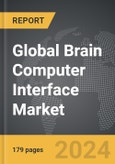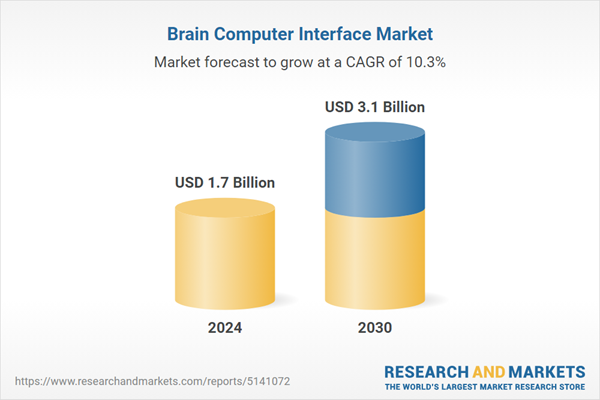The global market for Brain Computer Interface was valued at US$1.7 Billion in 2024 and is projected to reach US$3.1 Billion by 2030, growing at a CAGR of 10.3% from 2024 to 2030. This comprehensive report provides an in-depth analysis of market trends, drivers, and forecasts, helping you make informed business decisions. The report includes the most recent global tariff developments and how they impact the Brain Computer Interface market.
Segments: Application (Healthcare, Gaming and Entertainment, Communication and Control, Other Applications); Type (Invasive BCI, Noninvasive BCI).
Geographic Regions/Countries: World; United States; Canada; Japan; China; Europe (France; Germany; Italy; United Kingdom; and Rest of Europe); Asia-Pacific; Rest of World.
The analysts continuously track trade developments worldwide, drawing insights from leading global economists and over 200 industry and policy institutions, including think tanks, trade organizations, and national economic advisory bodies. This intelligence is integrated into forecasting models to provide timely, data-driven analysis of emerging risks and opportunities.
Global Brain Computer Interface Market - Key Trends & Drivers Summarized
Why Is the Brain Computer Interface (BCI) Market Gaining Traction in Healthcare and Beyond?
The brain-computer interface (BCI) market is gaining significant traction due to its revolutionary potential in healthcare, rehabilitation, and even entertainment. BCIs enable direct communication between the brain and external devices, allowing users to control computers, prosthetics, or other systems through brain signals alone. In healthcare, BCIs are used for neurorehabilitation, helping patients with spinal cord injuries, strokes, or neurodegenerative diseases regain control of movement or communication. Beyond healthcare, BCIs are being explored in fields such as gaming, virtual reality, and defense, where they can enhance user experience and control by tapping directly into cognitive functions. This wide range of applications is fueling interest in BCI technologies.How Are Technological Advancements Shaping the Future of Brain Computer Interfaces?
Technological advancements are key drivers of growth and innovation in the BCI market. Improvements in machine learning, artificial intelligence (AI), and neuroimaging techniques have greatly enhanced the accuracy and efficiency of BCIs, making them more viable for real-world applications. Innovations in non-invasive BCIs, such as electroencephalography (EEG) headsets, are making these devices more user-friendly and accessible. Additionally, advancements in implantable BCIs, where electrodes are placed directly on the brain, are providing more precise control for users, particularly in medical applications such as controlling prosthetic limbs. These developments are expanding the potential of BCIs, moving them from research laboratories into commercial markets.What Role Does Neurorehabilitation Play in Driving Demand for BCIs?
Neurorehabilitation is one of the most promising areas for BCI applications, driving significant demand for these technologies. BCIs offer hope to patients with motor impairments, such as those resulting from strokes, traumatic brain injuries, or spinal cord injuries, by helping them regain control of their limbs or communicate with caregivers. These interfaces allow for neurofeedback and brain stimulation techniques that can aid in neural recovery and improve motor function over time. Additionally, BCIs are being used to develop advanced prosthetics that can be controlled by thought, offering a lifeline for patients with amputations or severe paralysis. As healthcare systems increasingly embrace personalized and adaptive rehabilitation technologies, BCIs are becoming a cornerstone in neurorehabilitation programs.The Growth in the Brain Computer Interface Market Is Driven by Several Factors
The growth in the brain-computer interface market is driven by several factors, including advancements in AI and machine learning, increased demand for neurorehabilitation solutions, and the expanding use of BCIs in non-medical applications. The development of more affordable, non-invasive BCI systems is broadening their accessibility, particularly in the consumer market, where gaming and virtual reality applications are generating new interest. In healthcare, the growing focus on rehabilitation for neurological conditions is creating strong demand for BCI-based therapies. Additionally, the integration of BCIs in defense and communication technologies, where they offer potential for enhanced human-machine interaction, is further driving market growth. As these technologies mature, the BCI market is poised for substantial expansion across diverse sectors.Report Scope
The report analyzes the Brain Computer Interface market, presented in terms of units. The analysis covers the key segments and geographic regions outlined below.Segments: Application (Healthcare, Gaming and Entertainment, Communication and Control, Other Applications); Type (Invasive BCI, Noninvasive BCI).
Geographic Regions/Countries: World; United States; Canada; Japan; China; Europe (France; Germany; Italy; United Kingdom; and Rest of Europe); Asia-Pacific; Rest of World.
Key Insights:
- Market Growth: Understand the significant growth trajectory of the Invasive BCI segment, which is expected to reach US$1.5 Billion by 2030 with a CAGR of a 11.6%. The Noninvasive BCI segment is also set to grow at 9.2% CAGR over the analysis period.
- Regional Analysis: Gain insights into the U.S. market, valued at $483.7 Million in 2024, and China, forecasted to grow at an impressive 9.5% CAGR to reach $459.8 Million by 2030. Discover growth trends in other key regions, including Japan, Canada, Germany, and the Asia-Pacific.
Why You Should Buy This Report:
- Detailed Market Analysis: Access a thorough analysis of the Global Brain Computer Interface Market, covering all major geographic regions and market segments.
- Competitive Insights: Get an overview of the competitive landscape, including the market presence of major players across different geographies.
- Future Trends and Drivers: Understand the key trends and drivers shaping the future of the Global Brain Computer Interface Market.
- Actionable Insights: Benefit from actionable insights that can help you identify new revenue opportunities and make strategic business decisions.
Key Questions Answered:
- How is the Global Brain Computer Interface Market expected to evolve by 2030?
- What are the main drivers and restraints affecting the market?
- Which market segments will grow the most over the forecast period?
- How will market shares for different regions and segments change by 2030?
- Who are the leading players in the market, and what are their prospects?
Report Features:
- Comprehensive Market Data: Independent analysis of annual sales and market forecasts in US$ Million from 2024 to 2030.
- In-Depth Regional Analysis: Detailed insights into key markets, including the U.S., China, Japan, Canada, Europe, Asia-Pacific, Latin America, Middle East, and Africa.
- Company Profiles: Coverage of players such as ANT Neuro, Brain Products GmbH, Compumedics Ltd., EMOTIV, Inc., g.tec medical engineering GmbH and more.
- Complimentary Updates: Receive free report updates for one year to keep you informed of the latest market developments.
Some of the 12 companies featured in this Brain Computer Interface market report include:
- ANT Neuro
- Brain Products GmbH
- Compumedics Ltd.
- EMOTIV, Inc.
- g.tec medical engineering GmbH
- Interactive Productline IP AB
- InteraXon, Inc. (Muse)
- iWinks LLC - Aurora
- Natus Medical, Inc.
- Neuroelectrics Barcelona S.L.U
- NeuroSky, Inc.
- Puzzlebox Productions LLC
- Ripple
Tariff Impact Analysis: Key Insights for 2025
Global tariff negotiations across 180+ countries are reshaping supply chains, costs, and competitiveness. This report reflects the latest developments as of April 2025 and incorporates forward-looking insights into the market outlook.The analysts continuously track trade developments worldwide, drawing insights from leading global economists and over 200 industry and policy institutions, including think tanks, trade organizations, and national economic advisory bodies. This intelligence is integrated into forecasting models to provide timely, data-driven analysis of emerging risks and opportunities.
What’s Included in This Edition:
- Tariff-adjusted market forecasts by region and segment
- Analysis of cost and supply chain implications by sourcing and trade exposure
- Strategic insights into geographic shifts
Buyers receive a free July 2025 update with:
- Finalized tariff impacts and new trade agreement effects
- Updated projections reflecting global sourcing and cost shifts
- Expanded country-specific coverage across the industry
Table of Contents
I. METHODOLOGYII. EXECUTIVE SUMMARY2. FOCUS ON SELECT PLAYERSIII. MARKET ANALYSISIV. COMPETITION
1. MARKET OVERVIEW
3. MARKET TRENDS & DRIVERS
4. GLOBAL MARKET PERSPECTIVE
UNITED STATES
CANADA
JAPAN
CHINA
EUROPE
FRANCE
GERMANY
ITALY
UNITED KINGDOM
REST OF EUROPE
ASIA-PACIFIC
REST OF WORLD
Companies Mentioned (Partial List)
A selection of companies mentioned in this report includes, but is not limited to:
- ANT Neuro
- Brain Products GmbH
- Compumedics Ltd.
- EMOTIV, Inc.
- g.tec medical engineering GmbH
- Interactive Productline IP AB
- InteraXon, Inc. (Muse)
- iWinks LLC - Aurora
- Natus Medical, Inc.
- Neuroelectrics Barcelona S.L.U
- NeuroSky, Inc.
- Puzzlebox Productions LLC
- Ripple
Table Information
| Report Attribute | Details |
|---|---|
| No. of Pages | 179 |
| Published | April 2025 |
| Forecast Period | 2024 - 2030 |
| Estimated Market Value ( USD | $ 1.7 Billion |
| Forecasted Market Value ( USD | $ 3.1 Billion |
| Compound Annual Growth Rate | 10.3% |
| Regions Covered | Global |









